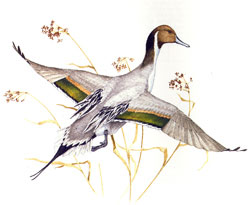Find a Bird - BBA1
Breeding Bird Atlas 1 Species Accounts
Northern Pintail
Anas acuta
Egg Dates
April 11 to May 22
Number of Broods
one; may re-lay if first attempt fails.

The Northern Pintail is rightfully thought of as a prairie duck. Its greatest numbers occur in the mixed prairie region of Canada and the adjacent tier of northern states, although it breeds throughout much of the Arctic as well. Although there are only a few restricted breeding areas in eastern Canada, there is some evidence that the pintail, like several other duck species, has been extending its range eastward. Here in Massachusetts, pintails nest at the coastal Parker River and Monomoy national wildlife refuges. In the late 1950s, about thirty ducklings were released at the Ipswich River Wildlife Sanctuary in Topsfield, but there is no direct evidence to link those birds to the few scattered breeders now in the Commonwealth.
Pintails are rare to uncommon spring migrants in the state. Most pass through in March and April. Pair formation, accompanied by ritualized displays, occurs during the winter. Pintails tend to nest in open areas of short vegetation, often farther from water than other ducks. The coastal habitat of Massachusetts is a somewhat unusual nesting habitat, but it is not unprecedented because pintails do nest in coastal areas of Alaska.
Hens will use a variety of vegetative covers for nesting and lay an average clutch of seven to eight gray-buff to pale olive eggs. Incubation lasts 22 to 23 days. During the Atlas period, a female with ten young was observed on June 14 at Parker River National Wildlife Refuge. Post-Atlas records from this area are June 13 (a female with eleven young) and July 15 (a female with eight young) (BOEM). The ducklings reach flight stage in six to seven weeks.
During late summer and early fall, wandering juveniles can be found away from the coast. The species is more common as a fall migrant. Males, which desert their mates at the start of incubation, tend to molt and migrate earlier than the females.
Pintails in the prairies winter along the Gulf Coast and in the mid-Atlantic region. Although it is not known where our birds overwinter, it is possible that they never leave the state. Small but increasing numbers of pintails winter on Cape Cod in Barnstable and Yarmouth. A few of these are banded each winter, and some return in subsequent years. Cape birds do not appear to be from the prairies because no banded birds have been reported from that area. However, recoveries have occurred in Ontario, Quebec, and Newfoundland, suggesting that pintails wintering in Massachusetts are either locally produced birds or breeders from eastern Canada.
Map Legend and Data Summary
Atlas 1 data collected from 1975-1979


Note: rare and very local; mostly in refuge impoundments and coastal marshes
H. W. Heusmann



